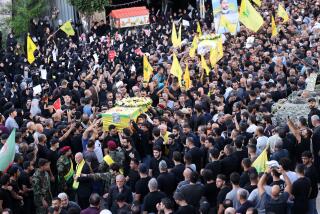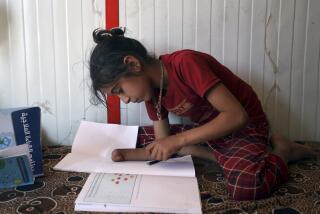U.S. military works to foil Afghan bombers
- Share via
Roadside bombs in Afghanistan are more likely to injure and kill U.S.-led forces than the ones planted in Iraq, even though the weapons manufactured by Afghan insurgents are more rudimentary, military figures show.
This is in part because they are so easy to make and difficult to detect, senior U.S. officers say. Afghan insurgents also use the devices to stage complicated ambushes involving teams of bombers and gunmen.
A military task force dedicated to countering improvised explosive devices, or IEDs, calculates that a casualty results from more than one in four bombs that troops encounter in Afghanistan. In Iraq, where the ratio was once 1 to 1, about six bombs are detonated or cleared per casualty.
Homemade bombs have not traditionally been a favored weapon in Afghanistan, say members of the military’s Joint IED Defeat Organization. Schooled in the Cold War-era guerrilla war against the country’s former Soviet occupiers, Afghan militants typically ambushed their adversaries with grenade launchers and AK-47 assault rifles, or fired rockets and mortar rounds from a distance.
But faced with a growing U.S. and NATO force, the militants appear to be taking a leaf from the Iraqi insurgent handbook, using bombs at least as often as any other type of weapon, members say.
The bomb force recorded 3,594 devices used in Afghanistan in 2008, more than twice the number in 2007. Army Lt. Gen. Thomas F. Metz, who commands the force, predicts a 50% to 60% increase this year as thousands of additional troops ordered into Afghanistan by President Obama push into areas that have long been under Taliban control.
“I believe we can do what we did in Iraq, and we can start beating the problem,” Metz said. “But I don’t think it’s going to occur before March ’10.”
Metz spoke to The Times on the sidelines of a recent conference in Huntington Beach that was aimed at enlisting the help of private firms, research labs and academics in developing new technology and tactics to protect against the bombs.
At least 154 U.S. and allied service members have been killed in bombings this year in Afghanistan -- four of them in a single explosion Thursday -- compared with 34 in Iraq, according to the independent website icasualties.org. Roadside, suicide and other kinds of bombings are also the leading cause of civilian war deaths in Afghanistan, killing at least 725 people last year, according to a United Nations report.
The United States already has poured billionsof dollars into the effort in Iraq, where the number of bomb attacks against American-led forces peaked at more than 2,500 a month in the summer of 2007.
Last year, there were 9,036 incidents, according to the military’s anti-bomb task force. Most of the attacks have been directed against Iraqi security forces and civilians since U.S. forces pulled out of cities at the end of June, military officials said.
“Iraq is an industrial society with an educated and predominantly urban population,” Metz said in e-mailed comments after the conference. “Consequently, the IEDs encountered in Iraq are relatively sophisticated, with a wide variety of switches and technologies employed.”
Among the most lethal are so-called explosively formed penetrators, which can pierce the armor of a tank. U.S. commanders accuse Iran, Iraq’s neighbor, of supplying Iraqi militants with the devices, charges that Tehran denies. But Metz said he has not seen evidence of the devices being exported to Afghanistan, on Iran’s eastern border, on a large scale.
Because most Iraqi roadways are paved, Metz said, insurgents would hide bombs in culverts and trash piles on the side of the road, then use cellphones, hand-held radios or even garage-door openers to set off the devices when crowds gathered or a convoy rumbled by. To prevent the bombs from detonating, U.S. researchers developed tools to jam the signals emitted by radio devices.
“We did really develop very good jammers,” Metz said at the conference. “We were able to push the enemy significantly away from radio devices. The problem was that, instead of more sophisticated, he went less sophisticated.”
Afghanistan is a vast, largely rural country with a population less educated than Iraq’s. Instead of radio initiators, Afghan bombers usually use command wires or crude pressure plates, which can be fashioned from two saw blades, some duct tape and scrap wire, Metz said.
The bombs are made from materials that are easy to find in a war zone, such as artillery shells and fertilizer. Because most roads are unpaved, militants can bury the devices in the ground and leave the wind and dust to camouflage the danger.
U.S. forces are experimenting with ground-penetrating radar to detect bombs before vehicles pass over them. But, Metz said, “there is all sorts of other clutter 18 inches under the road, and trying to develop the accuracy of the radar in order to not give you the false positives is pretty tough.”
The rugged terrain also plays to the advantage of the Afghan militants, he said. Although the population is larger than Iraq’s, it is scattered across a bigger country, with isolated valleys, surrounded by jagged peaks, giving bombers ample time and space to plant their devices.
Although the weapons are generally simple, “you don’t need to be technologically sophisticated to be effective,” said Army Col. Jeffrey Jarkowsky, who directs the anti-bomb effort in Afghanistan, known as Task Force Paladin. “The enemy is very clever about how he uses them.”
A bomb that explodes under a vehicle is more likely to cause casualties than one that goes off on the side of the road, he said, especially when it is packed with large quantities of homemade explosives.
Afghan militants also use suicide bombers and other explosive devices to stage complex attacks, often as part of a more conventional ambush.
In late July, waves of gunmen and suicide bombers, some of them disguised as women, attacked a U.S. military base in Jalalabad and several Afghan compounds in Gardez. At least six Afghan security officers and eight of the insurgents were killed during hours of fighting.
Metz’s organization, which was formed in 2006 with a three-year budget of $11 billion, is sending hundreds of analysts, trainers and ordinance disposal experts to Afghanistan this year. They are replicating many of the strategies developed in Iraq, such as equipping troops with jammers, ground-penetrating radar and wheeled robots to investigate suspected bombs from a safe distance.
The military also uses route clearance teams, surveillance aircraft, satellites and blimps to provide what it calls a “steady eye” over major transport routes.
But some modifications will be required in Afghanistan, officers say. The Pentagon is buying more than 2,200 lighter, more agile versions of the mine-resistant, ambush-protected truck, or MRAP, that are better suited to the rough Afghan terrain than the model developed for Iraq.
Metz said U.S. forces in both Afghanistan and Iraq detect 50% of the bombs they encounter before they explode and are using forensic methods to figure out how they were made and by whom.
Although U.S. commanders say these kinds of measures have helped reduce the threat in Iraq, they also credit a rapid buildup of U.S. and Iraqi forces, the rebellion of Sunni Muslim tribesmen against extremists in their midst and the decision of an influential Shiite cleric to stand down his militia.
Commanders say the U.S. buildup in Afghanistan, which is expected to boost the number of troops in the country to 68,000 by year’s end, will give them the forces to drive the Taliban from its havens and begin reconstruction, to undercut the militants’ support.
“The one sure way to defeat IEDs 100% is to defeat the insurgency,” Jarkowsky said.
More to Read
Sign up for Essential California
The most important California stories and recommendations in your inbox every morning.
You may occasionally receive promotional content from the Los Angeles Times.













